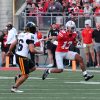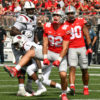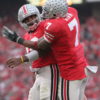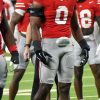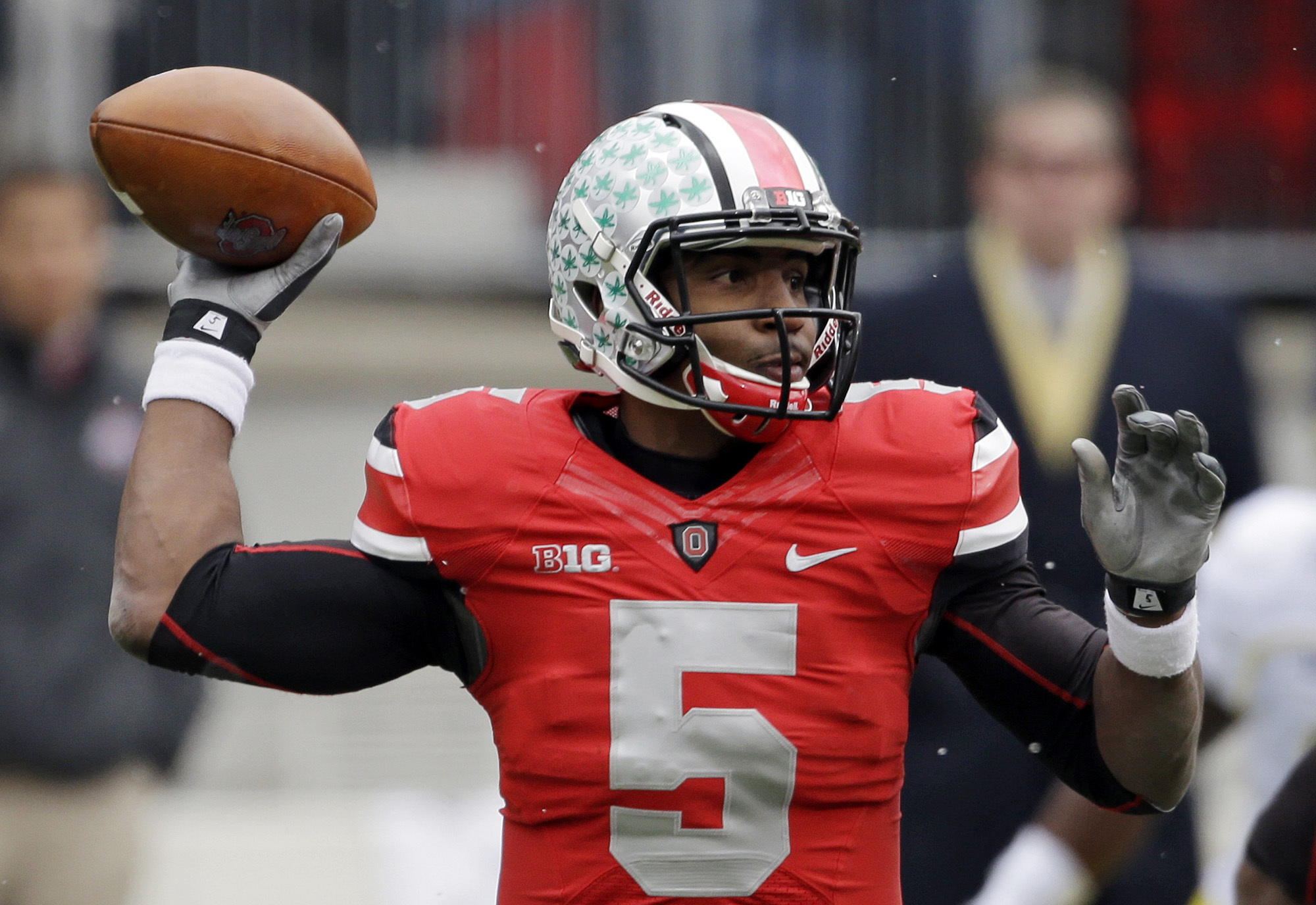
With the return of football up in the air, now serves as a perfect time for reflection on the history of football, and the strategic evolution of the game. To do that, the film study will be spending the offseason looking back at classic Ohio State games. Today’s film study takes a look at Ohio State’s 26-21 win over Michigan in 2012, and more specifically, Ohio State’s offense led by Braxton Miller. Video is from this cut-up. Yesterday’s film study can be found here. This is part two of two for this game.
While Ohio State’s rushing attack in 2012 was already nearing fully operational, the passing game was still very much a work in progress, almost by design. Urban Meyer and Tom Herman put a lot of the complexity of their offense into the rushing attack because quarterback Braxton Miller and halfback Carlos Hyde were plenty comfortable with advanced option and running schemes, but Miller was still very unsure about using his arm as a sophomore, and hadn’t yet picked up on some of the minutiae of reading a defense downfield.
Because of that, Meyer and Herman really looked to simplify the passing game, often limiting Miller’s reads and working hard to scheme top receiver Corey Brown open down the field, while leaving either Hyde or tight end Jake Stoneburner available as a safe option for Miller to hit underneath if things went awry. Most passing plays that this team relied on really utilized the threat of Miller as a runner to keep defenses from selling out to stop the pass, and to do that, Ohio State’s passing game was centered around rollouts and play actions, both of which put linebackers and safeties in conflict to create individual matchups for wideouts.
As the last throwback film study looked at the rushing attack for Ohio State’s 2012 offense, this one will look at the passing game’s basic concepts, starting with those rollouts.
ROLLOUTS
It’s funny to think that there was once a time when rolling the quarterback out of the pocket worked really well for Ohio State, given the fact that it seemed to be a consistently negative part of Tim beck’s offenses in 2015 and 2016. However, with Miller at the helm, the threat of him tucking the ball and just running to the perimeter was strong enough that defenses were forced to respect it, which Herman used to design routes down the field that could take advantage of a lack of coverage.
This first quarter touchdown is a great example. With Hyde serving as a lead blocker, Ohio State rolls Miller out to the right (while some quarterbacks are the opposite, he was much more comfortable throwing on the move to his dominant hand) to get him into his throwing rhythm and to shorten the distance between him and the intended target, Brown. With trips right, this is a simple look for the Buckeyes, but an effective one against Michigan’s defense. The outermost receiver is running a quick slant before stopping right on the hash mark in case Miller needs to dump the ball off. The tight end is getting vertical and heading for the corner of the end zone, and Brown is just darting out into the flat.
The slant screens both the linebacker and corner trying to get to the flat to stop Brown, and all Miller has to do is deliver a catchable ball for Brown to turn up field and race into the end zone. In short yardage situations, this is a very easy and smart way to keep a young quarterback comfortable and create an opening for him without making him read too much of the defense.
Part of why these rollouts worked was because of that threat to run, which Ohio State made sure to lean into by designed the occasional keeper off of a rollout to keep defenses honest, like on this play.
This has a similar design, with Hyde leading the way as a blocker, but Miller is keeping all the way here. The line is in zone blocking mode, with the center responsible for the back side linebacker and the tight end responsible for a scoop block, helping the play side tackle seal off the end before getting second level and chop blocking the play side linebacker. Everything up front goes to plan, and Miller has all sorts of room to run because of it. Again, nothing too complicated here, but the threat of a keep on one of the rollouts makes things much more difficult for opposing defenses.
Running almost the exact same play later on in the game, Miller again has a big gain, this time, even without the great blocking that he had on the first one. With an athlete like Miller at quarterback, the ability to free him up in space with a traditional zone blocking scheme was a massive plus for the Buckeyes and something that they tried to do frequently, and that they had a lot of success doing on these rollouts.
Even on plays like this one, where Miller is actually supposed to throw, the threat that he will continue outside and just tuck to run is so great that the linebackers take themselves completely out of the play to try to stop him. He sees that and cuts back into about 10 yards of wide open real estate, again taking advantage of the defense being forced into over-pursuing to try to stop him. That was really the name of the game with this offense, and with basically every Herman offense in Columbus: force the defense to compromise its structure to stop one part of the game, and then hit them with the exact opposite.
PASSING
That same concept applied to the play action passing game as well. Because Hyde and Miller were so dangerous running the ball, defenses were consistently too conservative when defending the play action, packing the box out of fear of a run. Ohio State loved to use that threat to hold safeties in place, leaving Brown and Devin Smith on the perimeter streaking downfield in single coverage, creating a much easier throw for Miller vertically.
It works out well early in the game, with Brown running a deep post off of an inside zone play action fake. The fake freezes the linebackers and holds the deep safety in place. With Michigan dedicating eight defenders to the box, Brown is left alone against a single cornerback, and just has to run a good route to beat him. He does, handily, and Miller has a nice big target to hit down the field for a huge gain. The key to these sort of plays is usually just blocking, because play actions require time to develop. However, with the threat to run that Miller presents, defenses were largely afraid to blitz, freeing up more time for these deep shots off play action.
The play action obviously wasn’t just a vertical look for the Buckeyes either, because that would risk a defense adjusting and shutting down the passing game entirely. To spread the defense out and keep those safeties and linebackers playing conservatively, Ohio State loved to use this nifty play action screen package, shown here.
With trips right, Ohio State has Brown flare on the sideline for a screen, using the interior receivers as downfield blockers. The play action keeps everyone that started in the box firmly within the hash marks, giving Brown and his blockers a three-on-three matchup on the perimeter. The blockers do their jobs, and Brown picks up a solid gain on another very easy throw for Miller. Simple, smart throws to work your young quarterback into the game.
Now, as mentioned, this was still very much a passing attack in the works, and a passing attack that got quite a bit better in 2013 because of improvement from Miller. Just as he was in the option game with a hesitancy to hold onto the ball, Miller was very timid in trying to throw into tighter windows down field. He was frequently too conservative in attacking defenses when his receivers weren’t wide open.
This play is a great example. Ohio State runs play action again, this time with a nice zone-beating flood concept on the right side of the field to counter Michigan’s zone defense (it looks a lot like cover 3, though it’s a bit too sloppy to tell for sure). Miller’s read is on that flood side, where he should be watching the box safety to see if he’s in man or zone. In man, the read is either hit the tight end in the flat, or, if you’re feeling bold, to attack that deep safety and test his ability to play through the receiver in the air.
In zone, as Michigan is here, Miller should see that box safety turning his hips to the sideline and immediately throw to Brown on his flag route, over the box safety and under the cornerback moving into a deep zone. The corner plays it pretty well, but this is still a very doable pass with good timing, and Miller just isn’t confident enough to try it.
It isn’t an exact comparison, but this throw a year later shows just how much Miller grew in a year under Herman. He’s passing on zone, and hitting a wide receiver over the first level of coverage but under the second level. The timing and velocity are spot on, and he puts the ball right where it needs to be. It’s amazing what Miller was able to do after just one year of work in this offense, and frankly, even a conservative projection of one more year of growth indicates that with Miller healthy for his senior season, Ohio State probably wins that 2014 title in a landslide. Obviously it doesn’t really matter now, but it’s too bad that Miller never got to paint his masterpiece, because he was building to something truly special.
Unfortunately, because of the bowl ban, the 2012 team has a complicated legacy in Ohio State lore. It was a very very strong team with an offense that frequently toed the line separating great and elite, but it was a team that never got the chance to earn any hardware for its hard work. A better way to consider that team is not as its final record, cut short after 12 games, but rather as the foundation for what would become an eventual national champion in 2014, and what would before that become one of the most electrifying and underappreciated offenses that Ohio State will ever see in 2013.
This team set the groundwork for all of that. The later Meyer teams featured offenses that were, essentially, a bad knockoff of this original greatness, with bad offensive coaches trying to copy what a good offensive coach had done before them. The 2015 and 2016 teams wasted their seasons chasing after what Herman and Meyer had perfected in 2013 and 2014, and all of that stemmed from the success that this team, specifically on the ground. Ryan Day has revitalized and reworked Ohio State’s offense into something that barely resembles this group, but it’s still hard for any offense to capture what Ohio State had in those three years.
Day is matching it, but he’s doing so in a far different way, using concepts in the air that look foreign compared to the much less complex schemes of Herman and Meyer. Both are tremendous, both to watch and to win games with, but there’s something unique and special about what Ohio State did with Miller at the helm, and as mentioned, it’s a shame that he never got to reach his final form in Columbus.





